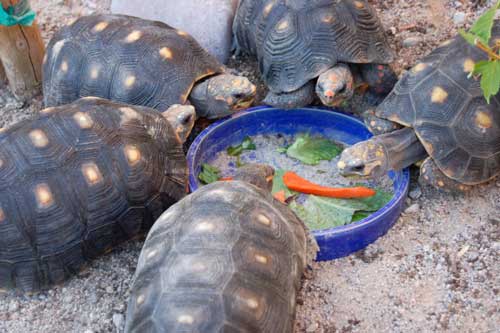They have a broad geographic range and can be found from the eastern Andes to Brazil Bolivia and Argentina. They do well in groups and often exhibit social behaviors.
 Red Footed Tortoise Care Sheet Reptiles Magazine
Red Footed Tortoise Care Sheet Reptiles Magazine
Red-Footed Tortoise Overview.

Can red foot tortoises live together. That means even very young tortoises naturally live on their own. In the wild tortoises live relatively solitary lives. They roam several acres and only occasionally encounter other tortoises.
They usually come together for breeding purposes but live most of their lives alone. Red-Footed Tortoises are native to grasslands and forests of Central and South America. Can Red Foot Tortoises Cohabitate with other Species.
Youll just have to try it and see. Considering that green iguanas and red-footed tortoises are both reptiles that can live in temperatures from 70-95 degrees Fahrenheit need humidity levels of about 75 need the same UVA and UVB. Do Not Mix Tortoise Species.
Just one of three tortoise species found in South America they are critical to the rainforest ecosystems they inhabit. Not only is their husbandry different their temperaments size differences and places of origin cannot be farther apart. If playback doesnt begin shortly try restarting your device.
In this they closely resemble African Hinge-back species of the genus Kinixys which they closely approximate not only in dietary preference but also in terms of occupying very similar habitat niches. Theoretically you could have tortoises from different species live together but even if you do everything right there is a chance that the tortoises will hate each other for no apparent reason. They can also be sizeable in adulthood with males regularly weighing 20 pounds or more and measuring 12 inches long.
The red footed tortoise hails from South America in the dense rainforests and grasslands. Theyre not known to get super territorial unless males are trying to impress a female for breeding. Part of the reason red foots need more water and humidity is their diet consisting of a higher protein content than most.
If a tortoise encounters another they will fight mate or both. Bringing a red footed tortoise into your life is a significant commitment as these tortoises can readily live for 50 years. Sphagnum Moss Cypress Mulch do not use any other kind of wood mulch A combination of Sphagnum and Cypress either mixed together or installed separately in different areas of the pen Sphagnum and cypress retain moisture well without molding and are not overly dusty when dry.
Just remember your existing tortoise has established that hes living in HIS territory and any new animal you add to it may be seen as something to chase out of the territory. Multiple tortoises of the same species can happily be kept together As mentioned above keeping more than one tortoise of precisely the same species does not in theory carry any risk of cross contamination of infection provided of course that neither is harboring an infection that does affect the. Forest species not only consume more water but also need a much more humid enivironment to live in.
You shouldnt handle your red-footed tortoise too much. HttpsgooglBecCMM Join the KK Army. Redfoot tortoises need high humidity 60 to 85 or so and temperatures that dont go much below 60 70 for hatchlings or above 95 degrees Fahrenheit.
In most cases these tortoises get along just fine. They sometimes do ok living in either pairs or males together. Red footed tortoises for sale along with yellow foot tortoise and the Cherry head tortoise all are tropical forest species of tortoise.
Its important that you avoid housing different tortoise species together. For the most part red-footed tortoises are docile. You can drastically decrease the chances of this happening by making sure that they have enough food enough space and that they feel comfortable in the enclosure so they need to have the right.
The truth is. RF tortoises may be the exception to the rule. Thats not to say that such species dont fight but theyre probably better suited to settling their differences quickly so that they can coexist in peace.
Substrate For Hatchlings and Juvenile Redfoot. Red-foot and Yellow-foot tortoises do not bask to the same extent as arid-habitat species and therefore obtain much of their D3 needs in nature from the animal component of their diet. For the safety of each type of tortoise I would not recommend keeping them together.
Female tortoises may guard their nests but they do not protect or raise their babies. If you live in a warm humid climate consider making an outdoor redfoot tortoise enclosure most redfoots do best living outdoors if conditions allow. Except for a few species like redfoot torts aldabras or pancake torts most tortoises are loners in the wild.
Can reptiles like lizards tortoises live and cohabitate together in captivitySubscribe. If youre looking at raising a red foot tortoise and you already have a sulcata tortoise you may wonder if you can save space and house the two species together Its not ideal to house a sulcata and a red foot tortoise. Videos you watch may be added to the TVs watch history and influence TV.
Red Foot tortoises and Pancake Tortoises for example live in colonies and will occupy the same living space or burrow in the wild.
ads
